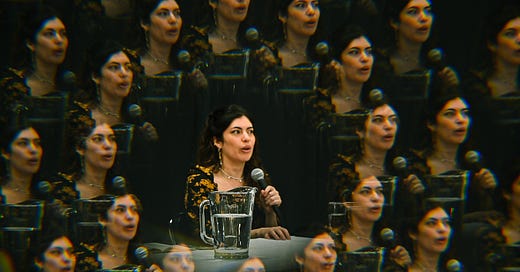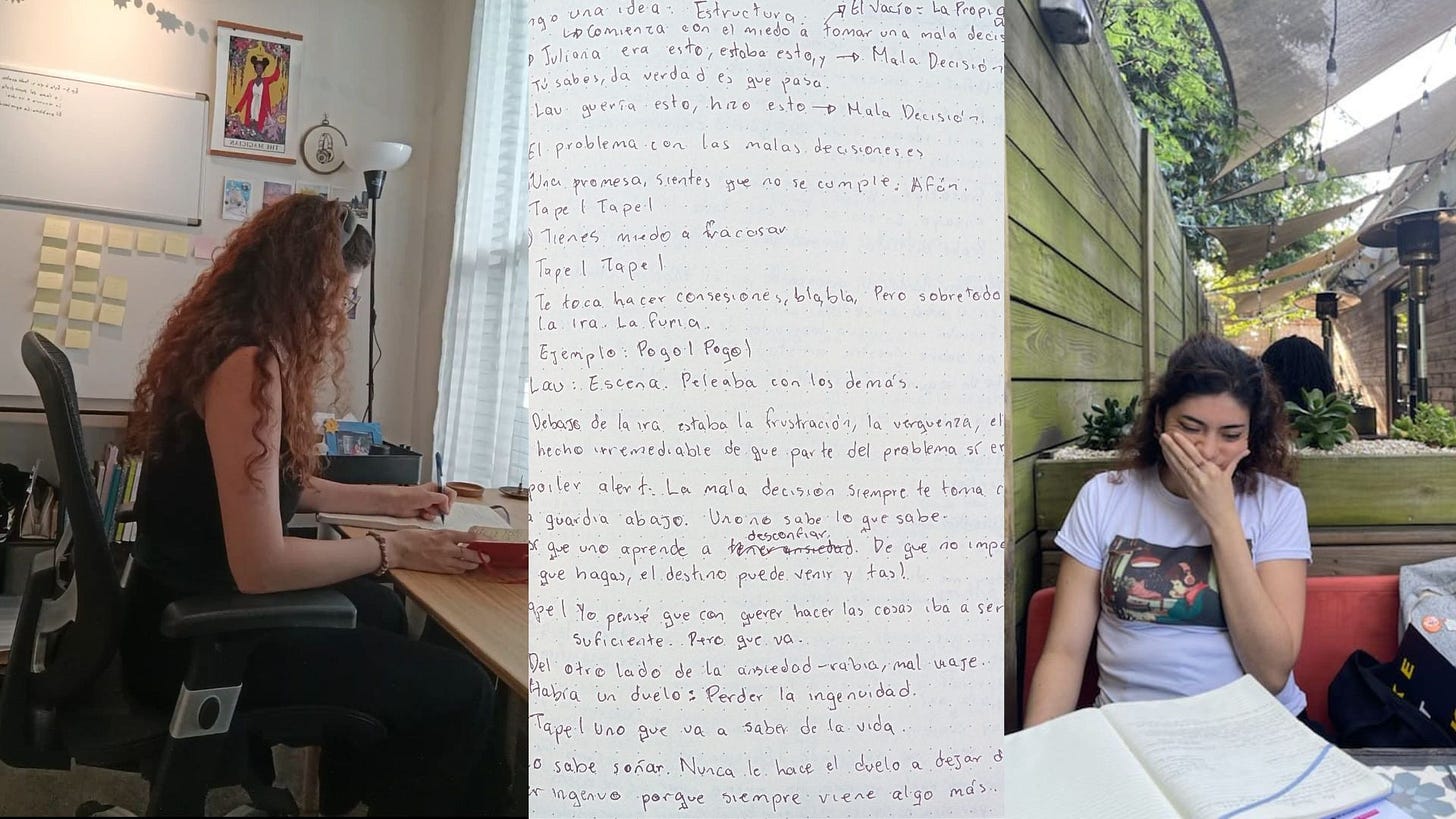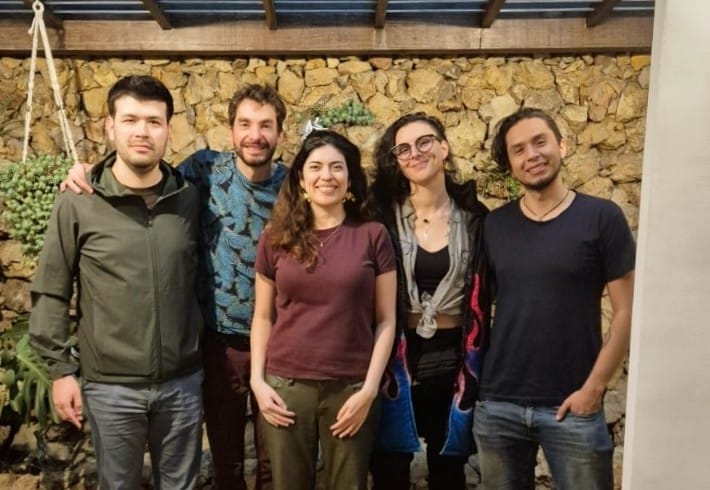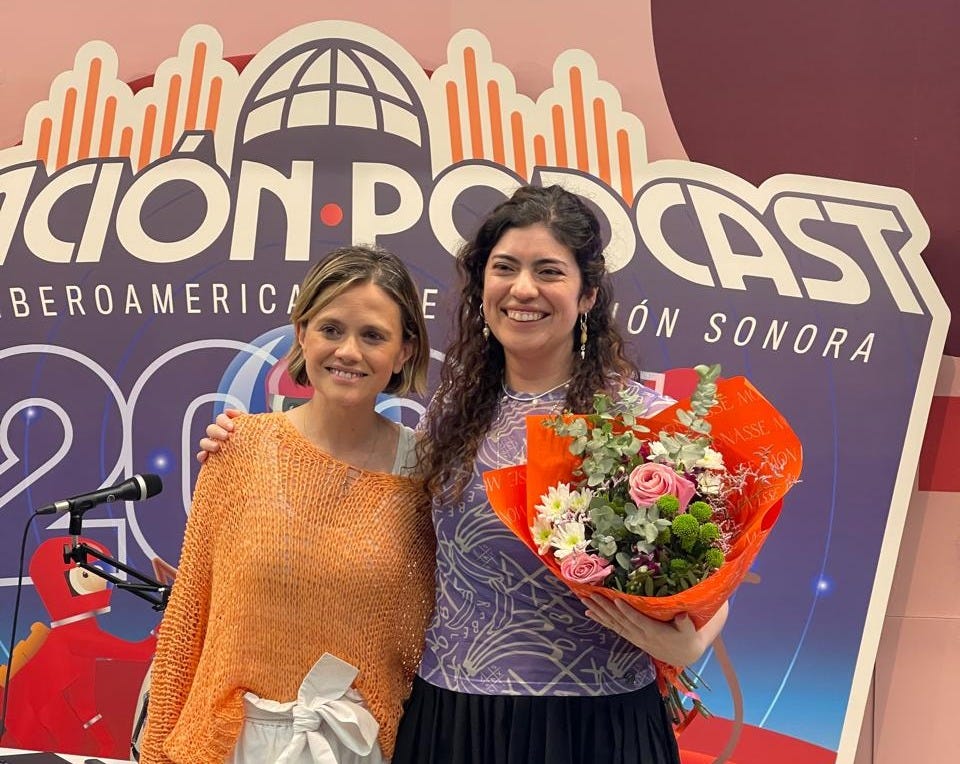A year of writing. Here is what I learned.
¡Hola!
The last days of December are like a long weekend. That's the best time to read this newsletter—resting, analyzing, and setting new goals.
I wrote my series this year, launched it, and showcased it in person in Spain and Mexico and virtually in two meetings. I am grateful. The project was reviewed in five Spanish-speaking media and met my audience. I made real what was previously a postponed project, and we have two remaining episodes of Juventud Maldito Vacío that we will release in January.
It's beautiful to see the pictures and say “We did it”. But I don't talk much about what it meant to make it happen. So, I want to write here what the trip was all about. For you, for me, for anyone who wants to take the plunge into writing a personal memoir project.
Because bringing a series into the world feels like sowing, cultivating, and harvesting: that's how I lived my year of writing.
Before we start: A big thank you to my paid subscribers. Your contribution was a direct contribution to my creative exercise and the creation, production, and distribution of this newsletter.
⛰️Sowing. December to February
Every creative act begins in the dark. That's where this series rested, in drafts, manuscripts, and audios, disorganized in a yellow and plastic folder in the dark back of my closet. Dark, like the long winter nights in Houston, when I got up in the middle of the night to write with the impulse that the time had come and that I had to bring this project from the depths of my memory to the light of blank paper.
Then I wrote on my laptop without knowing very well which way to go, I wrote with eagerness, as if I had to catch a train leaving right now. Several texts came from there, about how I imagined the series, how I wanted it to sound, why I was interested in that subject, and many other ideas scattered around. Not a full script, just pages halfway through. I had already started this way other times. But this January I did something different.
I organized a digital space for the project (folders, labeled recordings, a calendar, and a process) and a list of steps to execute all my ideas. I think when you have a dream project it's hard to start it because you want to do everything and at the same time you don't even know how to explain it. My instinct was to ask my colleague María Cuestas to interview me and María Linares to let us record the conversation at Fiona Records.
I said, “Interview me as if this were another interview podcast, and tell me if I have enough material to put a series together.
I spoke for three hours, but it felt like five minutes. I unlocked my story. Then I transcribed the entire interview, and for the first time, I could see my motivations and the project from a new perspective. It was about transitioning from youth to adulthood, about the major stages everyone goes through. I drafted the first outline of the series with María.
I also recorded supporting interviews, soundscapes, and conversations in the following days. The key exercise during this sowing phase was beginning to vocalize what I wanted to do: during calls with sources, in my first conversations with the team—that’s where I started believing in the project, literally putting it into words.
A tool that helped me: The Morning Pages.
Something I learned from The Artist’s Way by Julia Cameron. Each morning, as soon as I woke up, I wrote three pages about whatever was on my mind. Julia calls it “resting on the page.” When you wake up, your brain isn’t fully alert yet, which means your judgmental, overanalyzing self hasn’t woken up either. So you write down thoughts your subconscious has just processed. My journal became a compost of ideas and story structures. I realized I was most interested in the intersection between a personal story and the social moment I grew up in.
The Lesson:
At the beginning of any creative project, there must be a major exercise in intention. What am I sowing, and what do I want to harvest? There must be a structure to organize creative material and a commitment—not to the final result but to the process of achieving it.
I wanted a narrative series that would expand my skills as a writer.
🌱 Sprouting: March to May
I returned to Houston with lots of audio material, the series outline, and the titles for each episode. I knew the first one was about bad decisions. But there was a problem: I didn’t want to be the protagonist.
Rooted in journalism, I tried writing the first episode as a report that blended a character’s story with mine. It turned out very boring. Then I tried telling it solely through my interviewee’s voice—it was too confusing. I kept coming to the first drafts, and they didn’t make sense. In my mind, I would write as a hermit at my desk and finish it in two weeks. Nothing concrete came out of that.
Of course, I got frustrated. Then I discussed it on a video call with Laura Hernández, and she pointed out the obvious:
—You need to decide whether the story is about you or others. And you have to accept that you work better in a team. I can be your producer or edit your scripts if you want.
And of course, I agreed. That call changed the course of my creative process. I made two more versions: one as an “essay” and another as a “narrative” (assuming I was the protagonist). I showed them to Laura and Maru Lombardo. Both agreed the narrative format was the right one because, through my voice and story, I could dive into the emotional core of youth, and it was clear why I cared so much about the topic.
At the same time, I had a brainstorming session with Nilsson. On a board, we treated the series as if it were an animation or a film project. What did I want to say, and how did I want to say it? That’s where the visual and sound aesthetic of the project was born. Then Laura and I set a timeline, dates, and a format: memoir.
A tool that helped me: Good old post-its.
I never get tired of saying this—seeing the material and being able to rearrange it physically always makes me feel like I can control it. Changing colors helps me set priorities, and my usual board helps me prototype quickly.
That’s how I wrote the first scripts: Episode 01 and Episode 04. First the pilot, then the episode that felt easiest for me to write. I was figuring out how to sustain the narrative voice throughout the series. Unlike other series I’ve written, this process was messy and experimental. Now that I think about it, I actively avoided writing Episode 2 because I knew it would demand a lot from me.
The Lesson:
Prototyping in many forms was necessary because, for a long time, I only had ideas about how I’d tell the story. But it wasn’t until this moment that I saw those ideas executed and realized they didn’t fulfill the mission. By the end of this phase, I decided to use my personal story as a device to develop the concept. I knew it was the only right way for me.
By April 2024, the solitary work of writing every day revealed not only the tone and format of Juventud Maldito Vacío but also gave me the courage to build a team to elevate the audio production and visual accompaniment. Reinforcements arrived: Nilsson, Sebastián, Daniel, Juan David, and Laura Correal. I started writing with the motivation to give them a beautiful story to work on. Right then, I was blessed to receive support from across the ocean.
🌻 Blooming: Festival Estación Podcast 2024
Here is a little present 🎁. Live, from the Círculo de Bellas Artes in Madrid, here is my launch of Juventud Maldito Vacío: a conceptual podcast in surround sound (Dolby Atmos), illustrations, original scoring, and animations. We dream big.
In this keynote, you can learn more about the conceptualization process of this podcast. It was the moment when my beloved project came to the public light for the first time, turning all my doubts into affirmations. Laura introducing me was one of the best moments of the year. I learned something in that flowering: as ambitious as I thought it was, I was ready to bring it to reality.
The big takeaway:
If you want to launch a Spanish-language project for an international audience, there are two key times to do it: just before summer (May/June) or in the fall (September/October). In the first one, you are aiming for vacationers to take the podcast with them on their trips or long car rides. In the second, you aim to gain the attention of the public just before the end of the year holidays and you can target live events or festival programming.
🌾Ripening. July - September.
When I returned, I focused on writing again all summer. I wrote with the drive to make up for lost time. I built myself an athlete’s routine: write, have breakfast, edit, have lunch, walk, write.
It was no longer about the motivation of starting the project—it had to be pure discipline now. Or so I thought. But the truth was, it took me hours to take the first step. I went through cycles of excitement, procrastination, self-indulgence, and frustration. I would spend an entire afternoon at a lovely café, rewriting every line, only to return home without a single new idea. It took me a while to realize what was happening. I was perfecting because it was easier than opening up about myself. I constantly doubted what was and wasn’t important to say.
And honestly, I was scared. Scared of not finishing, of disappointing others, of what people might think. I was afraid to show something so personal. In a world full of people who create podcasts spontaneously, I was going in circles because I felt insecure. I was terrified of publishing something weak, bad, or incomplete. I think this is a deadlock that all personal projects face at some point.
The turning point came at the end of July with Episode 2. I had a scheduled deadline with Daniel Murcia (Sound Designer) to deliver the voice cut. Up until five minutes before the meeting, I was still tweaking the script and changing words. I joined the call with an incomplete submission, and I’m not proud of that. It was the hardest episode to write because it was the most vulnerable one.
That day, I realized how much pressure I had put on myself. Daniel and Laura helped me let go. My fellow editors—Angelina Mosher, NK Kelly, Maru, and Lau—reminded me of what I had planted when I began this project.
I had to face the emotional work of writing and trust the process. Through writing, I realized this wasn’t about meeting expectations. Being honest and vulnerable was part of the project’s essence. And on the other side of fear, there wasn’t an enemy blocking my path, a terrible critique, or a muse of inspiration ready to fix everything.
There was just me, battling my perfectionism. If I kept writing, this dream project would have no choice but to become a real one. And that was the greatest triumph of all. So I kept going. I finished pages, recorded my voiceovers, repeated the process, and completed my episodes.
My Big Lesson:
The story and the act of writing are what drive creation forward—not the rush to make the story exist, not overthinking. You only learn to write by writing.
🏵️Harvest. September and beyond.
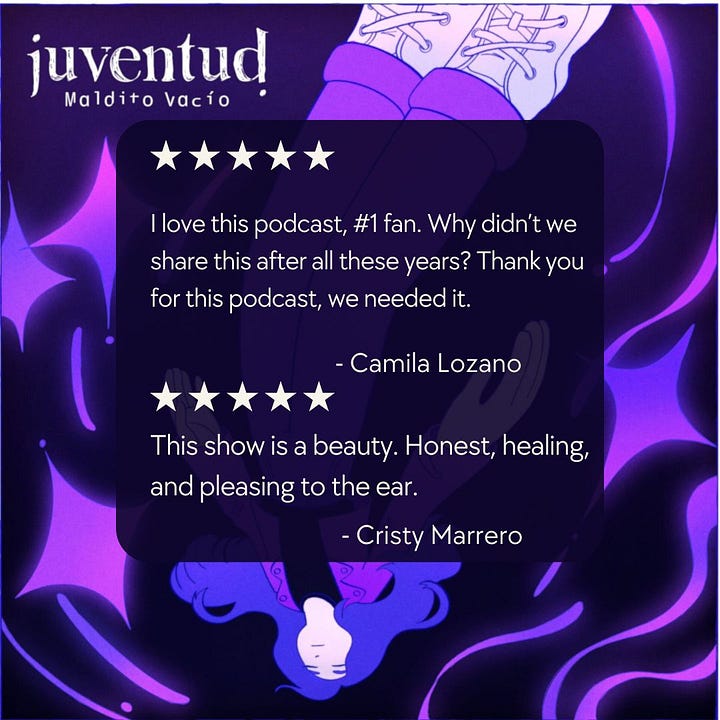
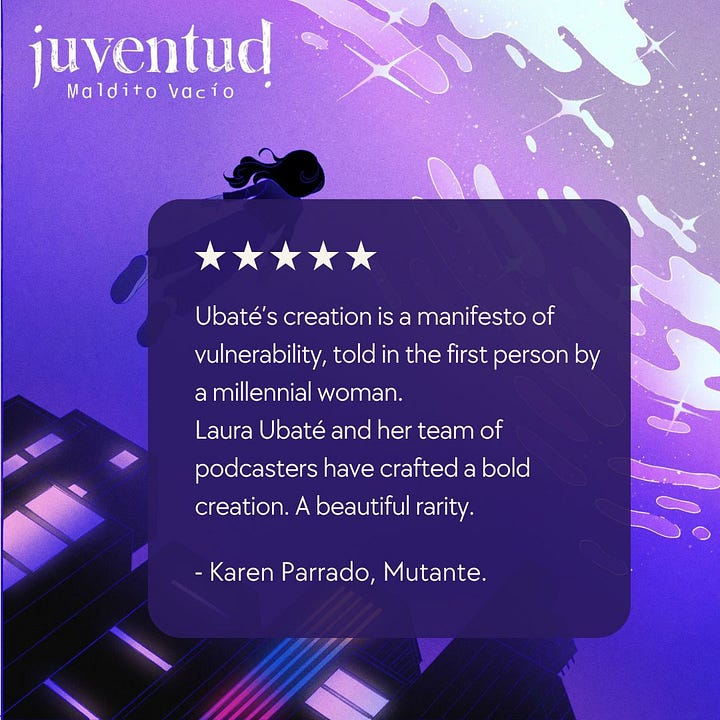

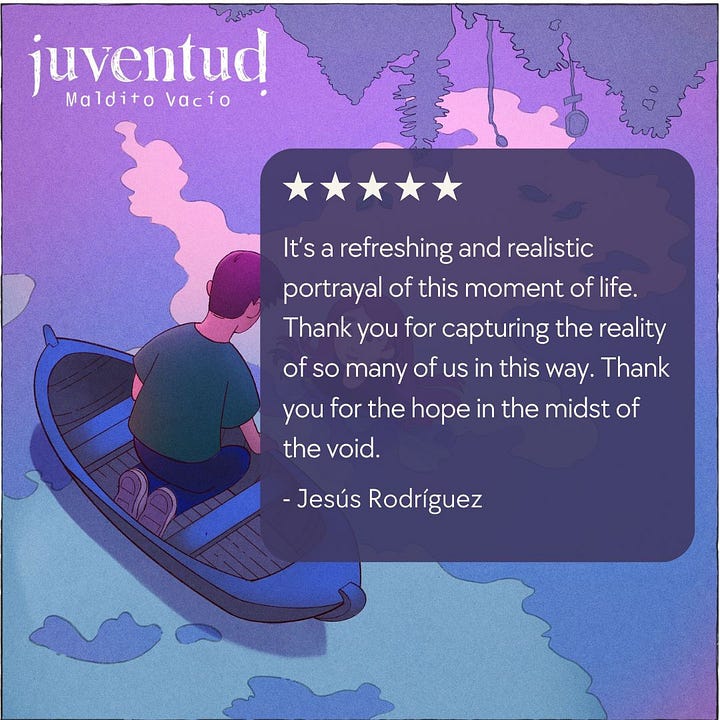
We premiered in September and released a new episode every three weeks. This is the result of a year of writing.
What began as a solitary act of writing has now become a shared work, with a team and an audience. In November, we showcased it live at the Sonar Festival in Mexico (here’s about the experience). I met my audience and realized that my story resonated with others—and that’s what matters most. Now, the work continues: we’ll finish releasing this podcast in January and bring it to those who need to hear it.
The creative journey doesn’t end with publication but with every connection it makes.
Infinite thanks to my team:
Assistant Director and Motion Graphics: Nilsson Cajamarca.
Production Coordination: Laura Hernández.
Editing: Angelina Mosher, NK Kelly, Maru Lombardo, and Laura Hernández.
Sound Design and Atmos Mixing: Daniel Murcia.
Assistant: Juan David Sarmiento.
Original Music by Sebastián Izáciga from El Mad Tree.
Illustration and Art Direction by Laura Correal.

